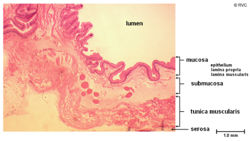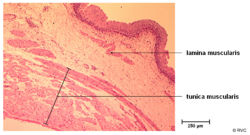Difference between revisions of "Urinary Bladder - Anatomy & Physiology"
| Line 30: | Line 30: | ||
* The '''trigone''' of the bladder gets its name as it looks like a triangle without a base. | * The '''trigone''' of the bladder gets its name as it looks like a triangle without a base. | ||
** It is of clinical importance and is formed by the paired uteric folds | ** It is of clinical importance and is formed by the paired uteric folds | ||
| + | ** These form by the orifice of the ureters | ||
** It is visible even when the bladder is full | ** It is visible even when the bladder is full | ||
** The folds extend from the urethral opening to the neck of the bladder | ** The folds extend from the urethral opening to the neck of the bladder | ||
| − | ** Where they merge | + | ** Where they merge to form the urethral crest |
| − | ** It is of differant embryological origin to the rest of tissue. More details can be found [[Developmental Anatomy of the Kidneys and Urinary Tract - Anatomy & Physiology#The Bladder|here]] | + | ** It is believed to have increased sensitivty and is of differant embryological origin to the rest of tissue. More details can be found [[Developmental Anatomy of the Kidneys and Urinary Tract - Anatomy & Physiology#The Bladder|here]] |
==Muscles of the Bladder== | ==Muscles of the Bladder== | ||
Revision as of 14:56, 2 September 2008
|
|
Introduction
- The bladder is where urine is stored before being expelled by the body through the micturition reflex.
- Without a bladder urinary continence would be impossible.
Anatomy
- It is a hollow, muscular organ
- It is divided for descriptive purposes into three parts
- Cranial Pole
- Intermediate body
- Caudal neck
- Its wall comprises a muscle layer covered in a transitional epithelial layer.
- Its size and posistion are determined by how full it is.
- When empty the bladder wall is wrinkled and thicker
- It rests on the pubic bones
- It is entirely in the pelvis of the large species but partly enters the abdomen of the carnivores
- It is largely retroperitoneal in the larger species
- When full and distended the folds dissapear and the wall appears thinner
- It then becomes intraperitoneal in the larger species
- When empty the bladder wall is wrinkled and thicker
- The trigone of the bladder gets its name as it looks like a triangle without a base.
- It is of clinical importance and is formed by the paired uteric folds
- These form by the orifice of the ureters
- It is visible even when the bladder is full
- The folds extend from the urethral opening to the neck of the bladder
- Where they merge to form the urethral crest
- It is believed to have increased sensitivty and is of differant embryological origin to the rest of tissue. More details can be found here
Muscles of the Bladder
The three muscular components of the bladder described below play a pivotal part in the micturition reflex.
Detrusor Muscle
This network of smooth muscle fibres lie in three sheets within the bladder wall and are supplied by both parasympathetic and sympathetic nerves. It is responsible for storage and expression of urine from the bladder.
Parasympathetic Supply - Detrusor Muscle
- S1-S3
- Synapse in pelvic plexus or bladder wall
- Pudendal nerve
- Innvervate the detrusor muscle
- Action - excitatory
- Function - empty bladder
Sympathetic Supply - Detrusor Muscle
- L1-L4
- Syanpse in caudal mesenteric ganglion - bladder wall
- Hypogastric nerve
- Receptor - beta 2
- Inhibitory action
- Allows bladder filling
Internal Urethral Sphincter
Its a thickening of the bladder musculature found at the neck of the bladder which is continous with the detrusor and is therefore smooth muscle. However unlike the detrusor its innervation is purely from sympathetic fibres.
Sympathetic Supply - Internal Urethral Sphincter
- L1-L4
- Synapse in caudal mesenteric ganglion
- Hypogastric nerve
- Receptor - alpha 1
- Excitatory action
- Function - retain urine through increased urethral tone
External Urethral Sphincter
Unlike the internal sphincter the external sphincter is composed of striated muscle fibres which are under the voluntary control of the somatic nervous system. It is often called the urethralis muscle.
Somatic Motor Supply - External Urethral Sphincter
- S1-S2
- Pudendal Nerve
- No synapse
- Innervates the urethral skeletal muscle - external urethral sphincter
- Function is to retain urine
The Ligaments of the Bladder
- Two lateral ligaments
- Insert in the dorsal abdominal wall
- Within them are the residual umbilical vessels which still have some patency and convey small amounts of blood to the cranial bladder
- They attach onto the bladder wall at the lateral vesical folds.
- Median ligament
- Connects the bladder to pelvic floor and linea alba
- Attaches into the bladder at the median vesical fold
- In the foetus this ligament supports the urachus.
Blood Supply, Innervation and Lymphatic Drainage
Blood Supply - Caudal vesicular artery
Lymphatic Drainage - Iliosacral lymph nodes
Alternative Anatomical Thinking
Some people now think that rather than an internal sphincter which contracts to resist urine outflow there is an actual structure which is opened when its muscle bundles contract. This would mean in these species that urinary continence relies on the external sphincter. It is not certain as yet which structure is correct but this idea does concur with the recent demonstration that the proximal urethra plays a role in urine storage in the dog and goat.

